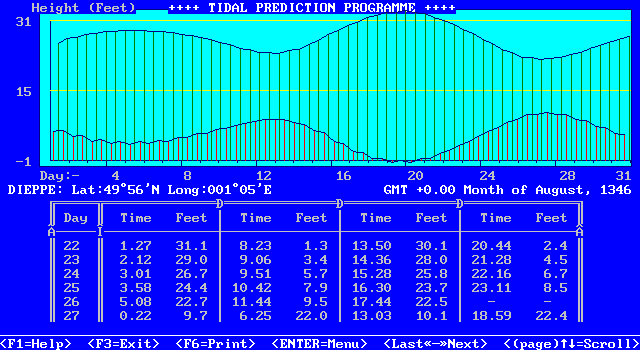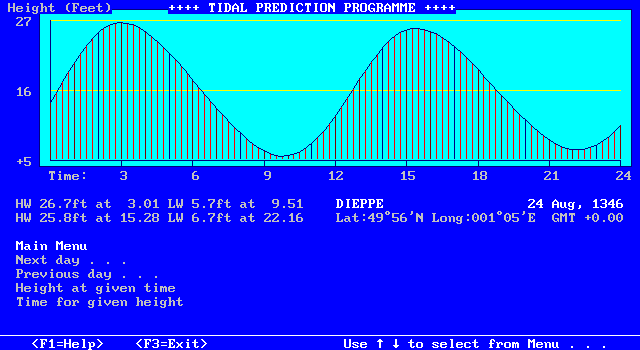Tidal study, Somme Estuary, 24 August 1346
Establishment of the times of the tidal extrema in the Somme estuary for August 24th 1346; and additionally times of sunrise, sunset and other ephemera.
Description:
The traditional location of the crossing (gué de Blanquetaque) used by Edward III prior to Crécy is said to be at the approximate limit of the tidal Somme, perhaps 8000 metres above St Valéry, however it is known that England traded with Abbeville, and shipping must therefore have been able to navigate over the ford. Also, the chronicles all say that Edward III awaited the low tide before attempting to cross.
The modern canal, railway embankment, dyke etc have removed all traces of the original and natural landscape.
Assumptions:
(i) The exact position of the gué de Blanquetaque is not known. For this study it is assumed to lie on the reach between Goui and Boimont on the left bank, and Grand-Port (Port-le-Grand) and Tombe de Paul on the right bank. References [3] and [11] mention Blanquetaque; the former stating: "... bourg de Port-le-Grand, à une petite distance au-dessus du gué de Blanquetaque...". Bellin, [2] planche 19, shows a number of shoal spots (1.5 to 2 pieds) approximately East of Saineville toward "G. Port". Despite an obvious scalar error in the 'toise' [10] (doubled to approximately 12.8 feet), we shall retain this general location for the ford.
(ii) What little credible evidence there is, would tend to demonstrate that silting has been in progress for several centuries. We shall therefore err on the side of considering that the volume of the estuary would, if anything, have been greater in 1346 than today (see caveat (a)).
(iii) It is also assumed that the gradient of the river bed was constant between Abbeville and the mouth of the Somme Estuary (here considered as Le Hourdel). Assuming, from the description above, that high water springs must have given a draft capability of 6 feet [13] [14] in Abbeville for access by traders, and that the channel depth at Le Hourdel at low water springs would also have been about this depth, then the tidal height at the presumed site of the gué would be some 19 feet above tidal datum. This statement is somewhat broad, but is not contradicted by any evidence, even anecdotal, that we have found.
(iv) That standard shoal water effects may be assumed, specifically Doodson [4] Progressive Waves, Chapter XVII, Standing Oscillations and Reflected Waves, Chapter XVIII and his conclusions Tides ... in Gulfs... Estuaries, Chapter XIX from which we retain the mathematical arguments of, inter alia, para 19.4
(v) That, as is expected from (ii), the tidal flow in the estuary of the Somme is stronger and appreciably shorter in time than the ebb; this is confirmed by local observation [7]; cf Forrester [12] "wave form distorted from its sinusoidal form ... the crest is found to propagate faster than the trough".
(vi) Modern time offsets [6] and [8] would indicate that Le Hourdel, at the mouth of the Somme but inside the offshore banks, would lag Dieppe by about 25 minutes (26 on HW neaps, 21 at HW springs), and St Valéry would lag a further 14 minutes neaps and 7 minutes at springs. By disregarding possible reflected wave effect, these offsets can be safely used for the mouth of the Somme estuary.
(vii) All astronomical algorithms are (first) based on recent resolutions of the International Astronomical Union; and use the new standard epoch J2000.0, the FK5 system, and new orbital theory and data from the Bureau des Longitudes in Paris. They can be safely assumed to be accurate to within a very few minutes for the period in question - and have been used for the almanac and tidal calculations.
(viii) We also assume that the "Old Style" (Julian Calendar) has been used for Thursday, Aug 24, 1346 (id est, Julian Day 2212919.5). We also will use GMT (Greenwich Mean Time) which for these purposes may be assumed to be the equivalent of TU (Universal Time).
Caveats:
(a) The Somme estuary is known to exhibit extensive movement of sand banks and mud flats; historic evidence suggests that this has always been a continuing process.
(b) The 16th century chart [1] is not helpful; the Bellin [2] chart (mid C18th) must be considered the earliest reliable work
(c) While there is no reason at all to doubt that today's harmonic constituents from the International Hydrographic Organization are relevant in this historic context (the geography and hydrology of the English Channel have been relatively constant), we do not have absolute proof of this assumption.
Conclusions:
Accuracy: For the above conclusions (A) may be considered accurate as to date, and to within one foot for amplitude; (B) and (C) may be considered accurate to within 30 minutes (98% probability) and more pragmatically to within fifteen minutes; (D), (E) and (F) accurate to within 75 minutes (98% probability) and more pragmatically to within half an hour.
Daily Almanac : all times Local = GMT + 0h 0m
|
Thursday, Aug 24, 1346 at 0h 0m 0s. Julian Day: 2212919.50000 At 50°09.000'N 1°44.000'E. Height 0 ft Equ of Time - 0h 0m 30s |
||
|---|---|---|
| SUN : Rise = 05h06m MOON : Rise = 13h07m |
Transit = 11h52m Transit = 17h52m |
Set = 18h38m Set = 22h33m |
|
New Moon : Aug 17, 1346 at 15h52m First Quarter: Aug 24, 1346 at 13h03m Full Moon : Sep 01, 1346 at 16h49m Last Quarter : Sep 09, 1346 at 09h24m |
||
| VENUS : Rise = 06h06m MARS : Rise = 08h01m JUPITER : Rise = 19h19m SATURN : Rise = 18h24m |
Transit = 12h36m Transit = 13h48m Transit = 01h20m Transit = 23h22m |
Set = 19h04m Set = 19h33m Set = 07h18m Set = 04h24m |
Monthly Tidal Predictions: astronomical data for Tidal Harmonic predictions for Aug 24, 1346 at 0h 0m 0s:
|
Mean Longitude of the Moon (L') = 234.1°
Mean Ecliptic Longitude Sun = 158.1° Longitude Mean Ascending Node Moon (N = -N') = 198.7° Longitude Mean Perigee = 139.2° Longitude Mean Perihelion = 271.7° |
|||||||||||||||||||||||||||||||||||||||||||||||||||||||||||||||||||||||||||||||||||||||||||||||||||||||||||||||||||||||||||||||||||||||||||||||||||||||||||||||||||||||||||||||||||||||||||||||||||||||||||||||||||||||||||||||||||||||||||||||||||||||||||||||||||||||||||||||||||||||||||||||||||||||||
|
|||||||||||||||||||||||||||||||||||||||||||||||||||||||||||||||||||||||||||||||||||||||||||||||||||||||||||||||||||||||||||||||||||||||||||||||||||||||||||||||||||||||||||||||||||||||||||||||||||||||||||||||||||||||||||||||||||||||||||||||||||||||||||||||||||||||||||||||||||||||||||||||||||||||||
Notes and bibliography:
Other documents consulted:
Offsets used (various sources):
Type: Tidal substation
13.5NM at 53° from Dieppe
Reference: Dieppe
High tide time: +0:06 neaps, -0:02 springs
Low tide time: +0:06 neaps, +0:11 springs
Type: Tidal substation
21.8NM at 45° from Dieppe
Reference: Dieppe
High tide time: +0:10 neaps, +0:07 springs
Low tide time: -0:08 neaps, +0:13 springs
Type: Tidal substation
25.2NM at 47° from Dieppe
Reference: Dieppe
High tide time: +0:26 neaps, +0:21 springs
Low tide time: +0:05 neaps, +0:18 springs
Type: Tidal reference
51.6NM at 21° from Dieppe
Despite being reference, offset from Dieppe
High tide time: +0:12 neaps, +0:22 springs
Low tide time: +0:34 neaps, +0:44 springs
Monthly Tides:

Monthly Tides
Daily Tides:

Daily Tides
